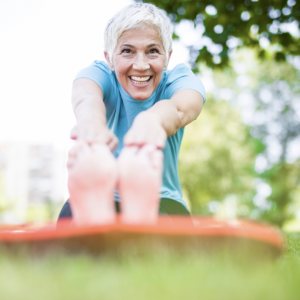Plantar fasciitis is something a majority of us would have experienced at some point, especially as we all tend to spend a lot of our day sitting or lying down! It is the tightening of the plantar fascia, which is a thick ligament connecting your heel to the front of your foot. As you can imagine, it undergoes a lot of pressure and shock throughout the day as we move!
What is it?
Plantar fasciitis is characterised by a dull or sharp pain at the bottom of the feet, often starting in one side but can be felt in both feet. Some people also feel burning as part of their symptoms.
After inactivity, such as when waking up in the morning or standing up after a movie or stint at your desk, the pain can be much more intense due to the fascia contracting.
Heat or ice – the real question
Plantar fasciitis, although named with the telltale ‘itis’ which implies inflammation, is more of a degenerative condition. This begs the question: would we use heat or ice for immediate pain relief? There is debate as to each of these options.
As is it more of a degenerative condition, heat therapy, such as a warm towel compress or heat bag, is more effective in improving blood flow to the area and encouraging healing factors. However, for immediate pain relief, ice is preferred as it will reduce blood flow to the area, reduce swelling and temporarily reduce nerve activity.
Heel spurs, common culprit!
Previously, health professionals would turn to heel spurs as the cause of heel and foot pain! Further study has indicated that heel spurs originate at an entirely different tendon which is much deeper to the plantar fascia tendon and sheath. Both manifest with pain at the bottom of the foot near the heel, so you can imagine why the two conditions easily masquerade as each other.
Long-term therapy options
It is important that treatment extends past acute heat and ice therapies. We need to ensure the plantar fascia goes back to its original role of shock absorber and provider of structure to the foot, and this is achieved through load management and addressing any other deficits in the body that could be contributing to the uneven load on the plantar fascia.
Tendon loading therapy relies on being progressive and case-specific. The loading capacity of a tendon depends on the activity level of the individual e.g. the patellar (knee-cap) tendon of a sprinter would be able to undergo much stronger loads than that of a sedentary individual. Therapy needs to introduce varying types of loading to ensure the plantar fascia is able to endure the loads it may meet in daily life.
Loading patterns for the plantar fascia can be achieved through movements such as a toes-elevated calf raise with the toes on a rolled up towel. This will allow the tendon to lengthen and compress under an easily modified load and therefore a gradual return to strength. It is very important to not overload the fascia to begin with as this could result in renewed or elevated symptoms.
Muscular control and tolerance: As with most injuries, especially tendon injuries, it is important to load the soft tissue around the area so as to reduce stress on the tendon itself. This needs to be done safely and progressively to avoid overloading the tendon. This includes exercises for the tiny muscles in the feet – yes believe it or not they need exercise too! Movements include toe spreading and toe curling and straightening with control.
Muscular deficits at other sites of the body can also have an impact on the functioning of the rest of the leg and therefore the foot. For example, if the hip muscles are weak and unable to keep the leg straight, the knee and foot will experience elevated twisting, resulting in an increased force for the plantar fascia to undergo. Exercises strengthening the hip rotators such as hip hitches, clams and abductions will help with this deficit.

